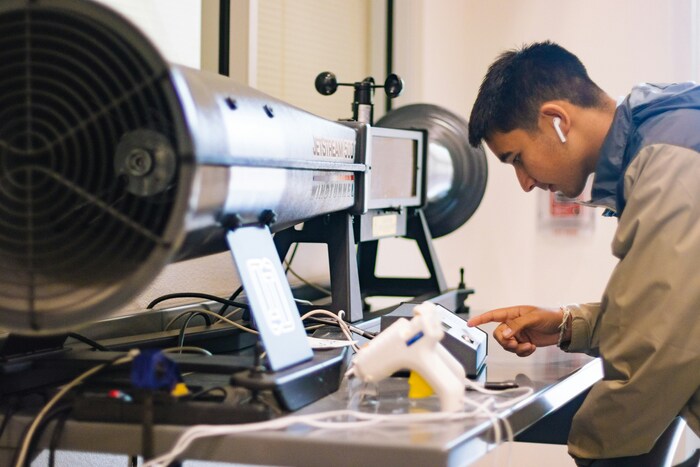There’s no denying that our modern world is intricately intertwined with Science, Technology, Engineering, and Mathematics —otherwise known as STEM. And as we move through daily life, the influence of STEM is vividly apparent all around us, from the ultimate reach our little smartphones provide to remarkable advancements in medicine.
Whether we realize it or not, STEM plays an essential role in various aspects of our lives. In 2024 alone, the human race witnessed considerable progress through STEM, such as innovations in AI, soft robotics, and other unique inventions. The luxuries and conveniences that STEM provides today were merely impossible for people just a few decades ago.
From space exploration to artificial intelligence, STEM has provided the human race with remarkable feats of innovation and progress. And all of the amazing achievements we’ve made in STEM started with education.
Think of STEM education as the launchpad for all of our modern achievements. It provides a strong base for curious minds and encourages students to explore and ask questions. During this time, individuals learn how to experiment and think critically and they develop important skills that will help them shape the future.
Today, let’s explore the impact of STEM on higher education and careers in 2024. And as we explore this fascinating subject, we’ll uncover how STEM education lays the groundwork for the trailblazers and innovators of tomorrow.
Understanding STEM
In a nutshell, Southern New Hamshire University defines STEM as an acronym that concentrates on 4 interrelated fields of study: Science, Technology, Engineering, and Mathematics. Because of these four STEM fields, our world experienced and witnessed advancements that influence how we live, work, and understand the world.
For instance, who would’ve thought that Artificial Intelligence would become a reality, shaping our lives as we know it? While existing in the past as mere products of science fiction, the AI tools we have today have allowed us to make self-driving cars, chatbots, and robots, and these are just a few examples among the many industries that AI already encompasses.
In the space exploration industry, the world was able to see the fascinating and awe-inspiring images taken by the James Webb Telescope, giving us a glimpse of distant galaxies and celestial wonders. Private space ventures like SpaceX have also entered the fray, with missions to colonize Mars becoming more plausible than ever before.
The plethora of the most recent STEM achievements doesn’t stop there. Of course, we shouldn’t disregard the remarkable human feats that have been discovered or invented that didn’t earn the spotlight but are surely paving the way for society’s advancements. Working behind the scenes, these advancements are quietly shaping the world as we know it.

History of STEM
In 2014, an article about what STEM education is and why it’s important was published in the Florida Association of Teacher Educators Journal. In the article, the author discussed the history and significance of STEM education over the years and how it shaped our country’s modern landscape.
The article cited that STEM Education, originally known as Science, Mathematics, Engineering, and Technology (SMET), emerged as an initiative by the National Science Foundation (NSF) to equip students with critical thinking skills and enhance their problem-solving abilities for the workforce.
While STEM principles were historically utilized in industries like engineering, they were not widely incorporated into traditional educational settings. However, historical events played a crucial role in shaping STEM Education’s development. The Morrill Act of 1862 led to the developing land grant universities that focused on agricultural training at first and engineering training later.
In World War II, STEM education revealed its significance in the war effort, as scientists and engineers worked with the military to develop a wide variety of technologies that ultimately shaped our collective history. And as the war came to a close, our country made sure to acknowledge and preserve the contributions of each talented individual—not just in weaponry.
A good example is the birth of National Aeronautics and Space Administration (NASA). In 1957, the launch of Sputnik by the Soviet Unio, eventually triggering the famous “Space Race” with the US. This event further encouraged the U.S. to prioritize technological advancements, which led to the “Space Act” in 1958 that formed NASA. Since then, NASA has thrived, from putting the first man on the moon to promoting STEM Education with grants and initiatives.
Ultimately, STEM Education’s history is rooted in the need to develop critical thinkers and problem-solvers, and its growth has been influenced by historical events that emphasized technological advancements and global competition.
Importance of STEM Education in 2024
In a report published by the National Science Foundation in 2020, their subcommittee investigated innovations in STEM Education, consulted experts and students, and drew inspiration from NSF’s 10 Big Ideas and NSB’s Vision 2030. Based on this, they established three priorities for STEM Education of the Future,
Firstly, they emphasized the importance of providing access and opportunities for all learners to explore and choose STEM careers, fostering a diverse and inclusive workforce that contributes to the innovation economy. Then, they focused on equipping learners with future-proof skills, with an emphasis on ethics to meet the demands of an ever-evolving world.
Lastly, they stressed the integration of appropriate technological innovations in learning spaces, whether in traditional classrooms or digital environments, with educators leading the way in leveraging modern technology to enhance context and enrich the learning experiences of students.
Of course, STEM education doesn’t just benefit our society, it also has its advantages for the individual as well. In 2021, researchers conducted a review on the impact of STEM education on student academic achievement. To gather pertinent data, the researchers compiled and analyzed 56 studies performed between 2014 and 2021 on the impact of STEM education on students.
It was found that STEM Education had a significant positive impact on student academic outcomes and success. And while considering various disciplines, the researchers also found that STEM Education has had the biggest positive effect on academic performance in the field of science.
Importance of STEM Education on Careers in 2024
As our world constantly evolves, the demand for STEM field workers is growing as the industry exponentially grows in the process. And recent occupational trends provided by the Bureau of Labor Statistics (BLS) prove this to be the case. In their report, they cited that STEM field occupations are expected to grow by 10.5% up until 2030, while non-STEM jobs are only projected to grow by 7.5%.
In a 2019 study, researchers looked to find out if employers in non-STEM occupations hired STEM graduates due to their specific knowledge and skills acquired from STEM education or if it was mainly because of their inherent problem-solving and analytical skills.
To gain some valuable insights for their study, the researchers examined online job postings in the UK and measured the STEM requirements in each of the jobs. They then classified each online job posting as either STEM or non-STEM fields based on its job description rather than considering the name of the occupation itself.
Surprisingly, the findings of the study revealed that 35% of all STEM jobs were actually included in non-STEM occupations. Conversely, 15% of all non-STEM job postings were classified under STEM jobs. Additionally, the study also found that STEM jobs tended to have higher wages as opposed to non-STEM occupations.
As the study suggests, it’s safe to say that pursuing STEM fields can prove to be a viable career path in the future, as it offers students with promising job prospects and career advancements. And, recent studies suggest that it can even promote essential skills that are required in the 21st-century workforce.
In 2019, researchers studied the utilization of STEM education in the early 21st century and its use in various countries, scientific fields, history, and skills required in the modern age. However, in this context, we’ll only discuss the skills required in the modern age and the ability of STEM to cultivate them.
The results of the review revealed that STEM education helped students gain the ability to solve real-life problems, as well as meet the rising demands of the 21st-century workforce through the combination of Science, Technology, Engineering, and Mathematics. The study also showed that STEM education aims to develop soft skills such as communication, teamwork, critical thinking, creativity, and the ability to innovate.

Recent Trends in STEM Education
Due to the increasing importance of STEM fields, it should come as no surprise that many American students have and are currently pursuing STEM education. In fact, During the 2020-21 academic year, there were a total of 437,302 bachelor’s degrees awarded in STEM fields in the United States alone. Meanwhile, 146,573 Master’s degrees were also awarded in STEM disciplines to boot.
And in 2022, researchers reviewed STEM education literature from the past 15 years and analyzed its global distribution and research trends. They collected 1,718 documents from the Web of Science (WOS) database and used a variety of tools to study their distribution over time, geographical locations, research topics, subject areas, learning stages, and citation impact.
The findings ultimately revealed that STEM education has gained significant scholarly attention, witnessing a heavy focus on interdisciplinary collaboration. Moreover, the review also found that social, cultural, and economic factors had a significant influence on how STEM education was implemented in different countries.
For instance, developed Western countries mainly placed their sights on educational equity and disciplinary integration, while developing nations focused more heavily on teaching practices. As for Eastern countries, they were more keen on enhancing humanistic leadership and cultural integration in STEM education.
Role of Higher Education in Shaping the Future of STEM
It’s pretty clear that STEM is an incredibly important aspect of the advancement of society. So, what role would higher education play in the future to spark an interest and eventually nurture students in the various fields of STEM? Well, in 2020, a researcher reviewed existing literature on the future of STEM education.
The review discussed the future of STEM education, which included teacher preparation, professional development, best practices, and reform. The researcher emphasized the need for qualified and motivated STEM educators with proper training to implement effective integrated STEM instruction.
Unfortunately, teachers may face barriers to providing quality STEM education, such as time constraints, lack of resources, and content knowledge deficiencies. To overcome these challenges, institutions should prioritize building confidence through formal and informal professional development and collaboration
As for the best practices in STEM education, this would involve student-centered lessons, inquiry learning, active participation, and social construction of knowledge. STEM reform should focus on promoting learning, thinking, and interest in STEM, with an emphasis on instructional quality, attitudes, and student motivation.
That said, aside from pedagogical aspects, some institutions should also focus on the social and cultural aspects of STEM as well. In 2021, researchers published an editorial entitled “Shaping the Future of Higher Education: Practical, Community-Driven Initiatives to Improve Academic Climate.”
This editorial highlighted that biases and stereotypes have created barriers for historically marginalized groups in STEM. To address this, graduate students at the University of California, Berkeley, initiated a diversity, equity, inclusion, and belonging (DEI&B) initiative. They collected data and organized town halls to address issues and improve the academic climate, along with monthly meetings to discuss topics related to identity and belonging.
The department also focused on mental health and wellness for students and improved mentorship and diversity in faculty hiring. They even established a Graduate Diversity Program to support DEI&B efforts.
Ultimately, the initiative has had a promising impact on these institutions, as it was revealed that there are still more plans to improve the experiences of these marginalized groups, one of which includes a five-year strategic plan for further enhancing DEI&B efforts.
Conclusion
It’s incredibly astonishing how STEM fields have been the constant force that pushes our modern society to innovate, prioritize technological advancements, and pursue scientific discoveries. And it’s safe to say that STEM education is humanity’s ticket to continual growth and progress not only in society but in individuals as well.
In the end, STEM fields aren’t just merely about advancing the frontiers of knowledge and creation—it’s also about forming a world where everyone has an equal chance to succeed and shape a better future for all of mankind.















